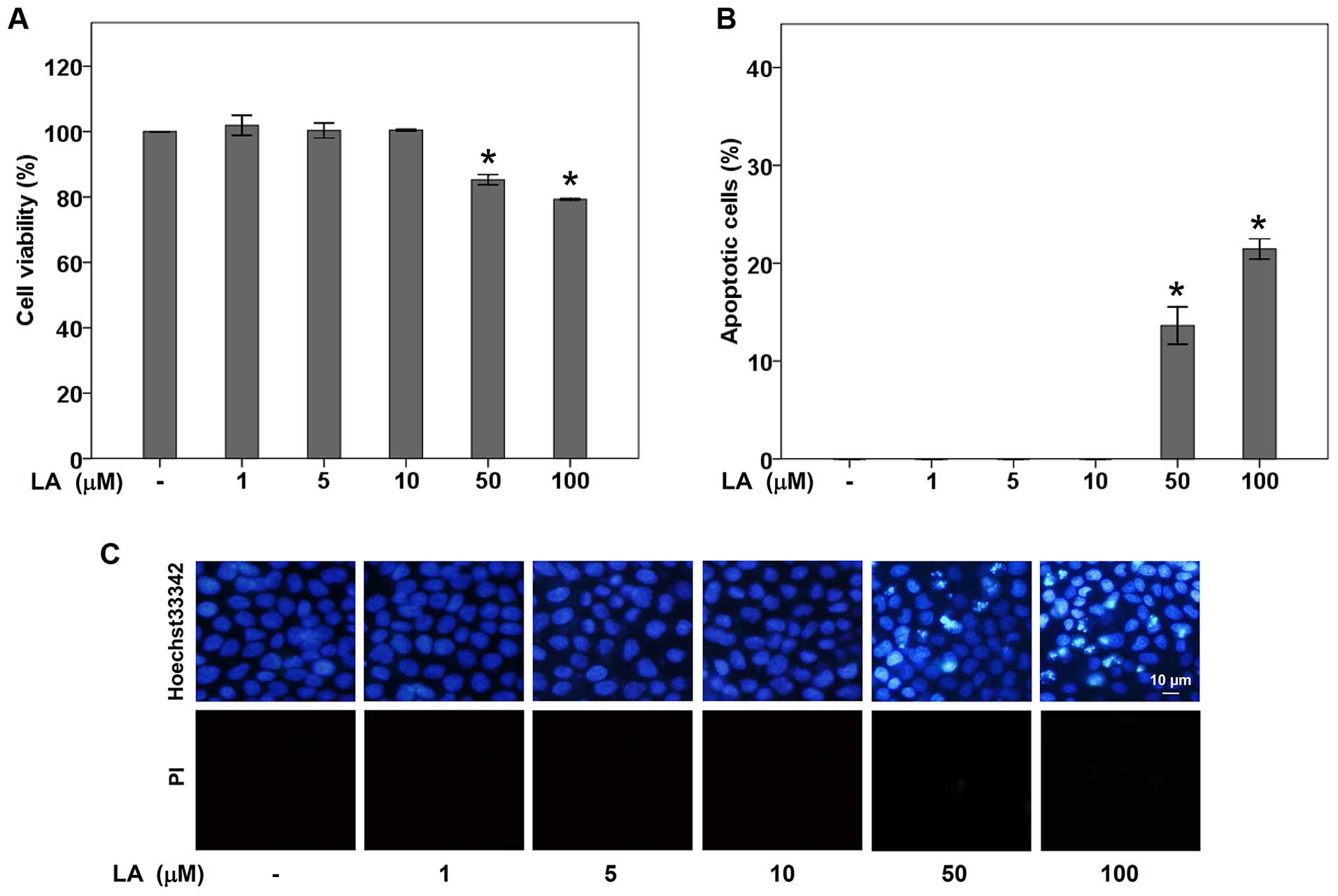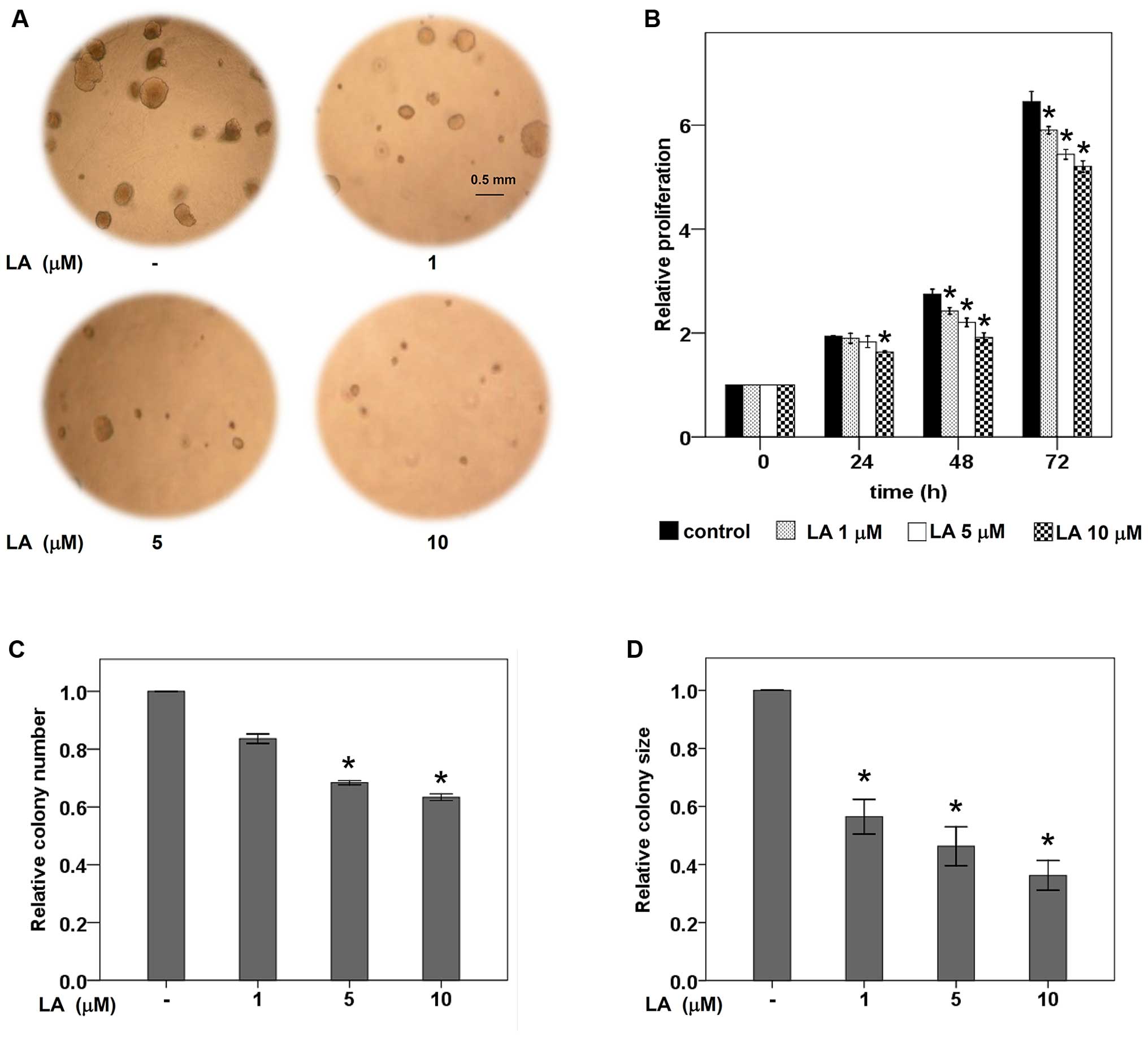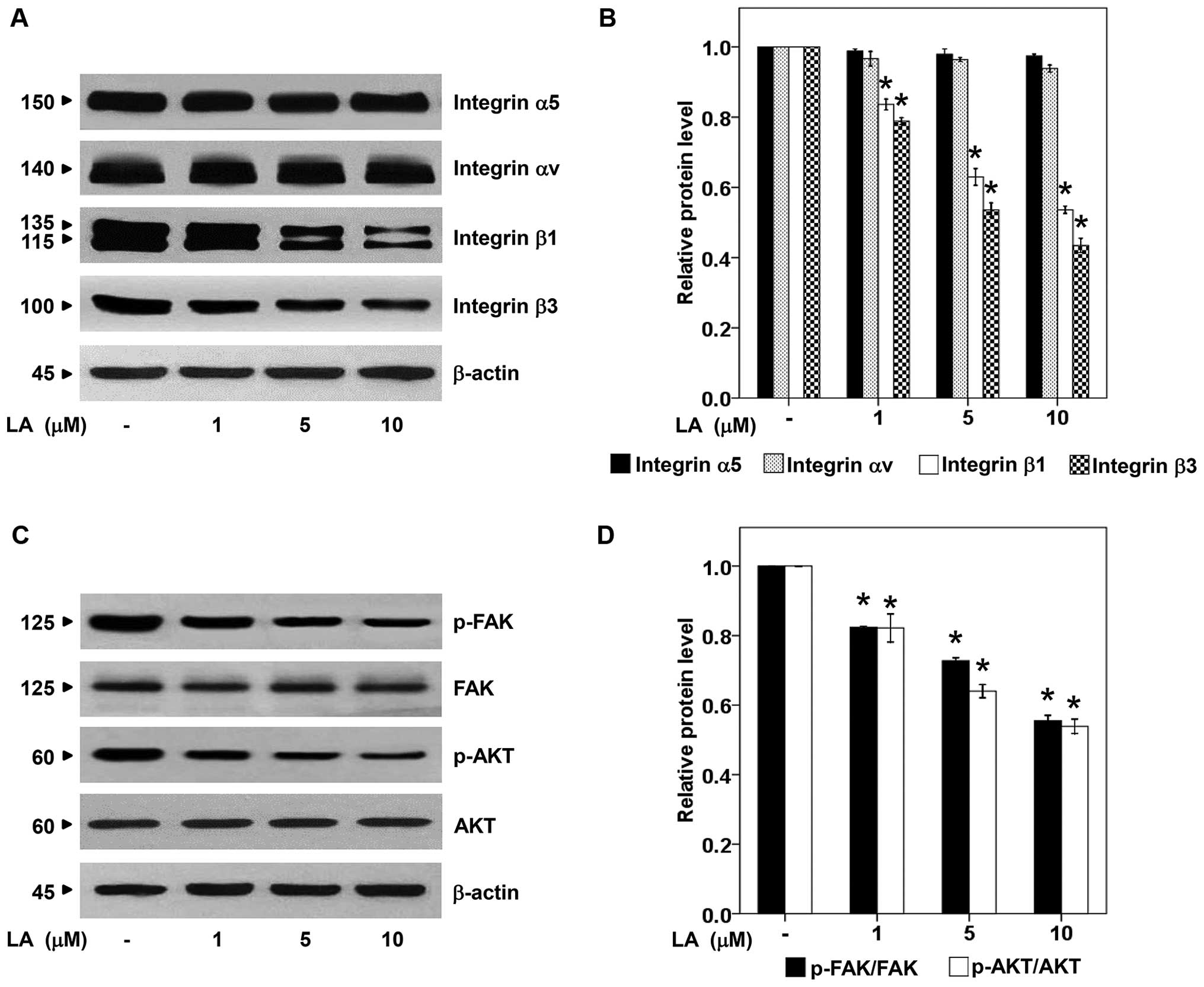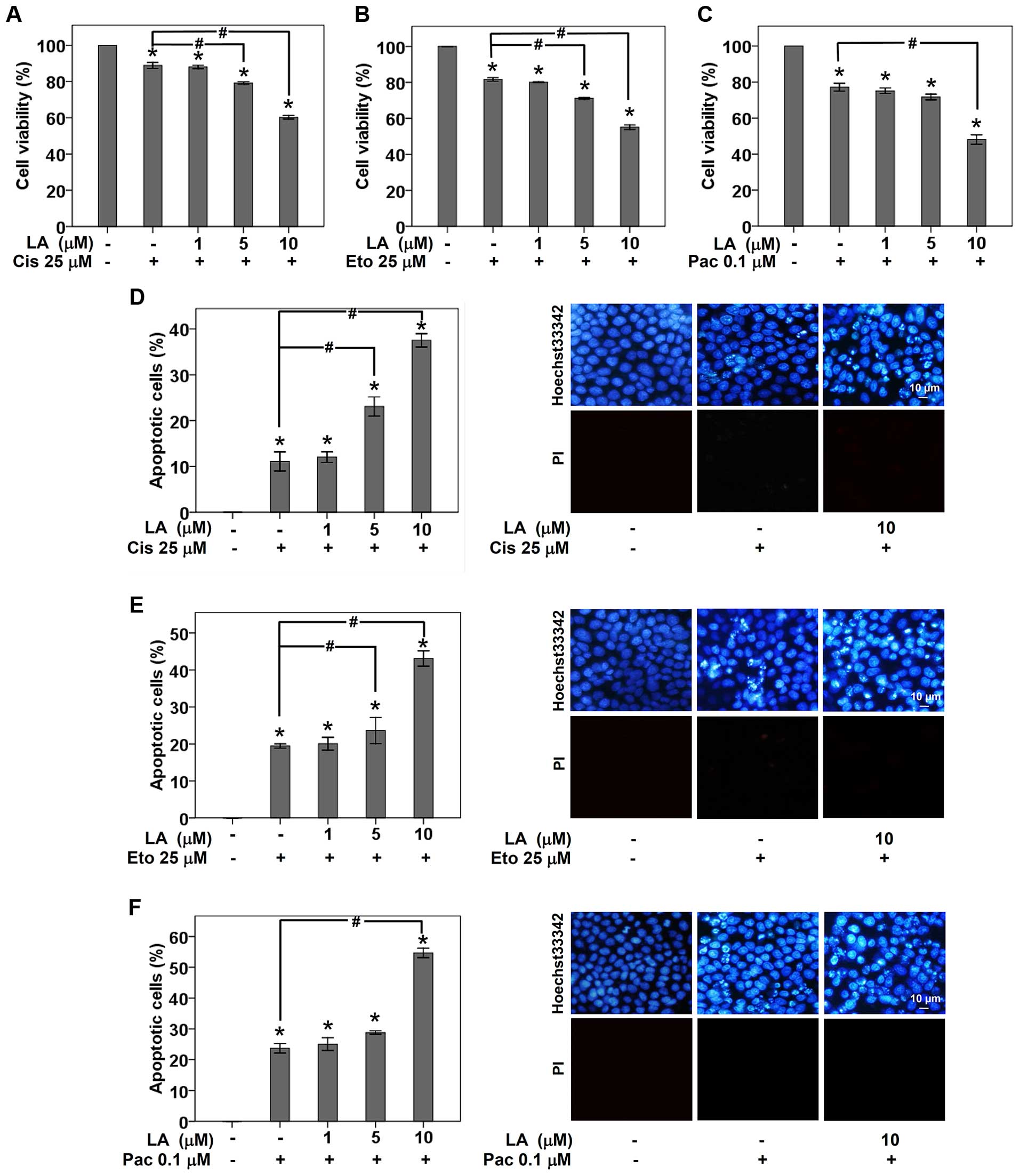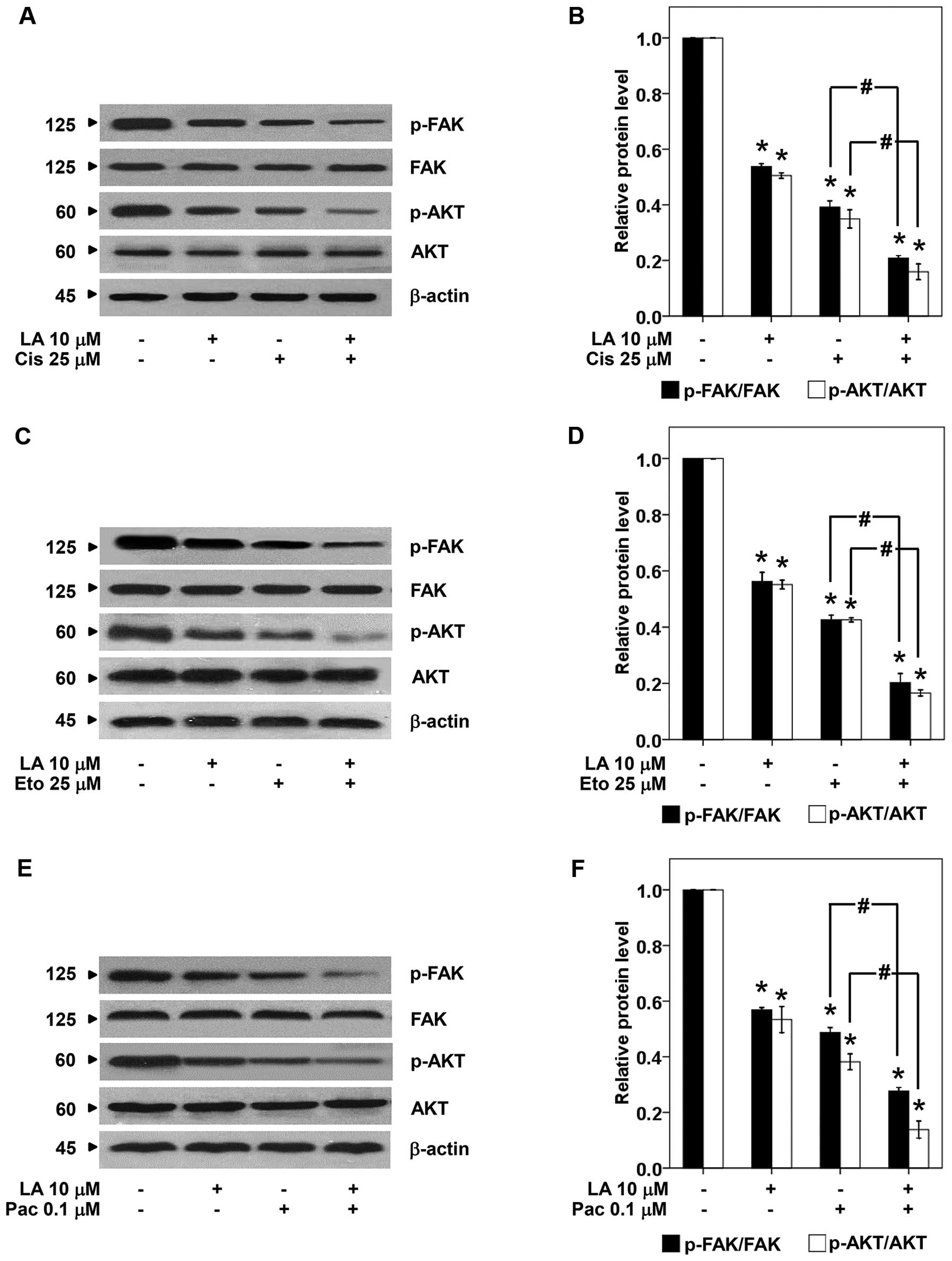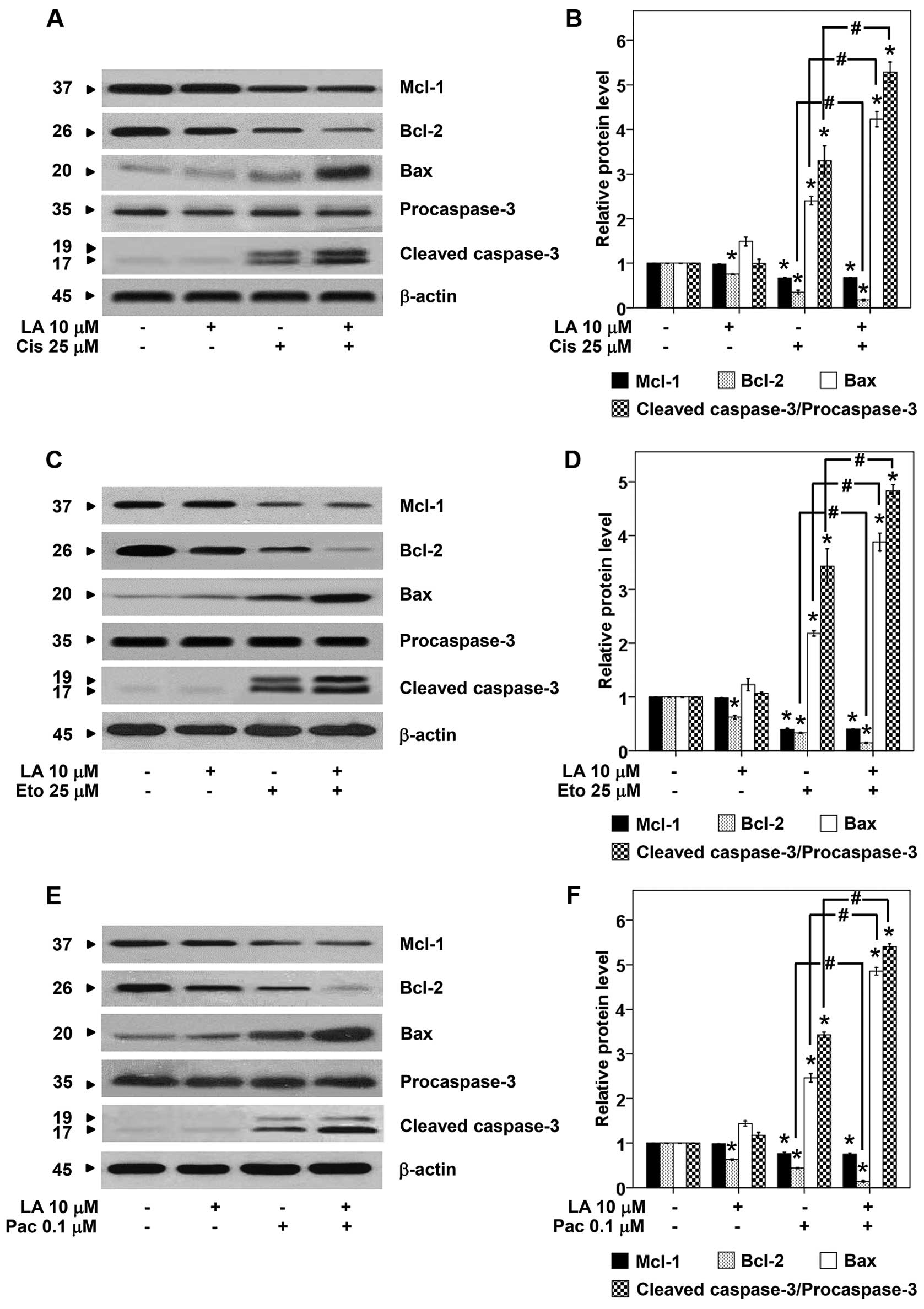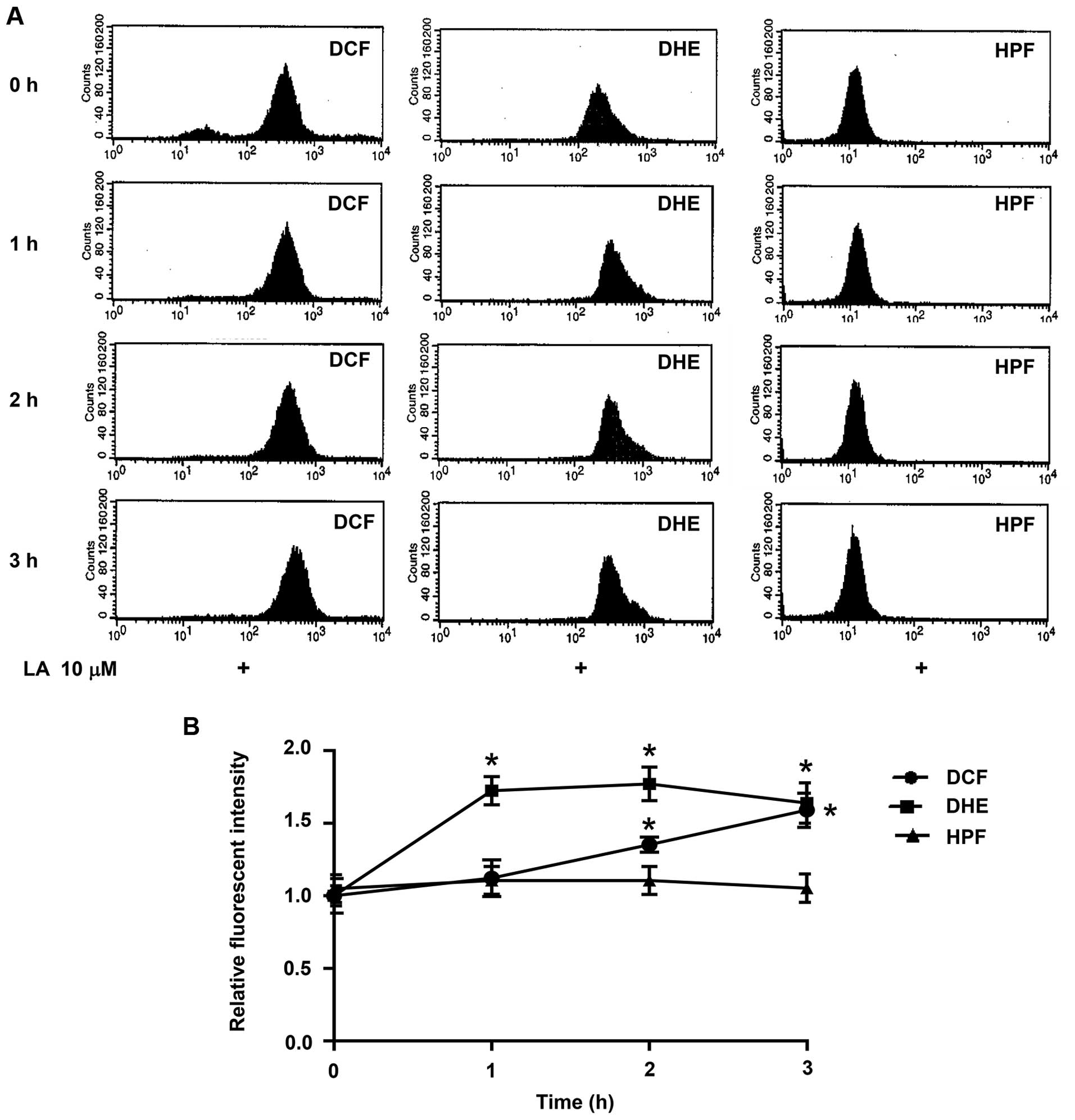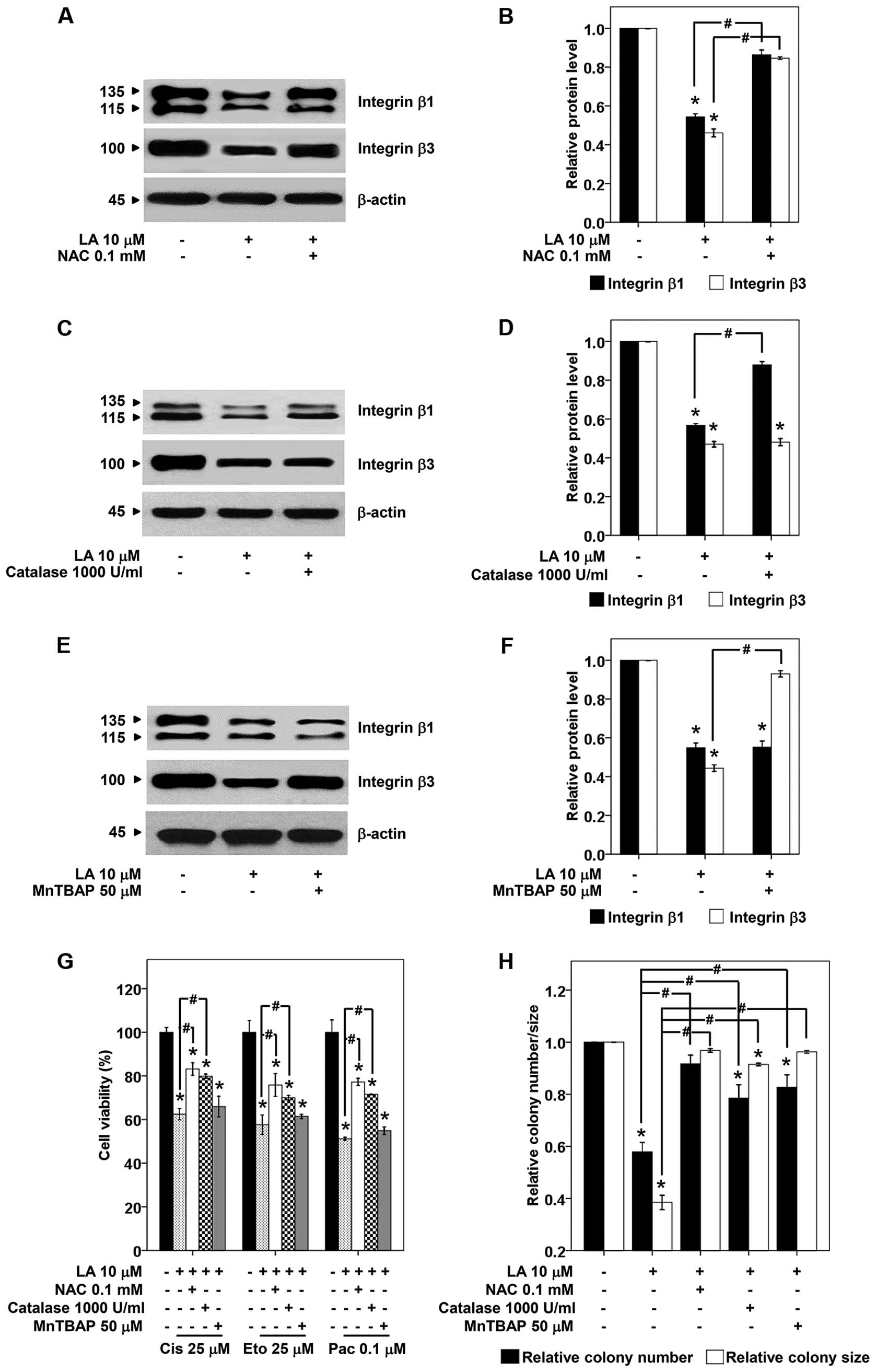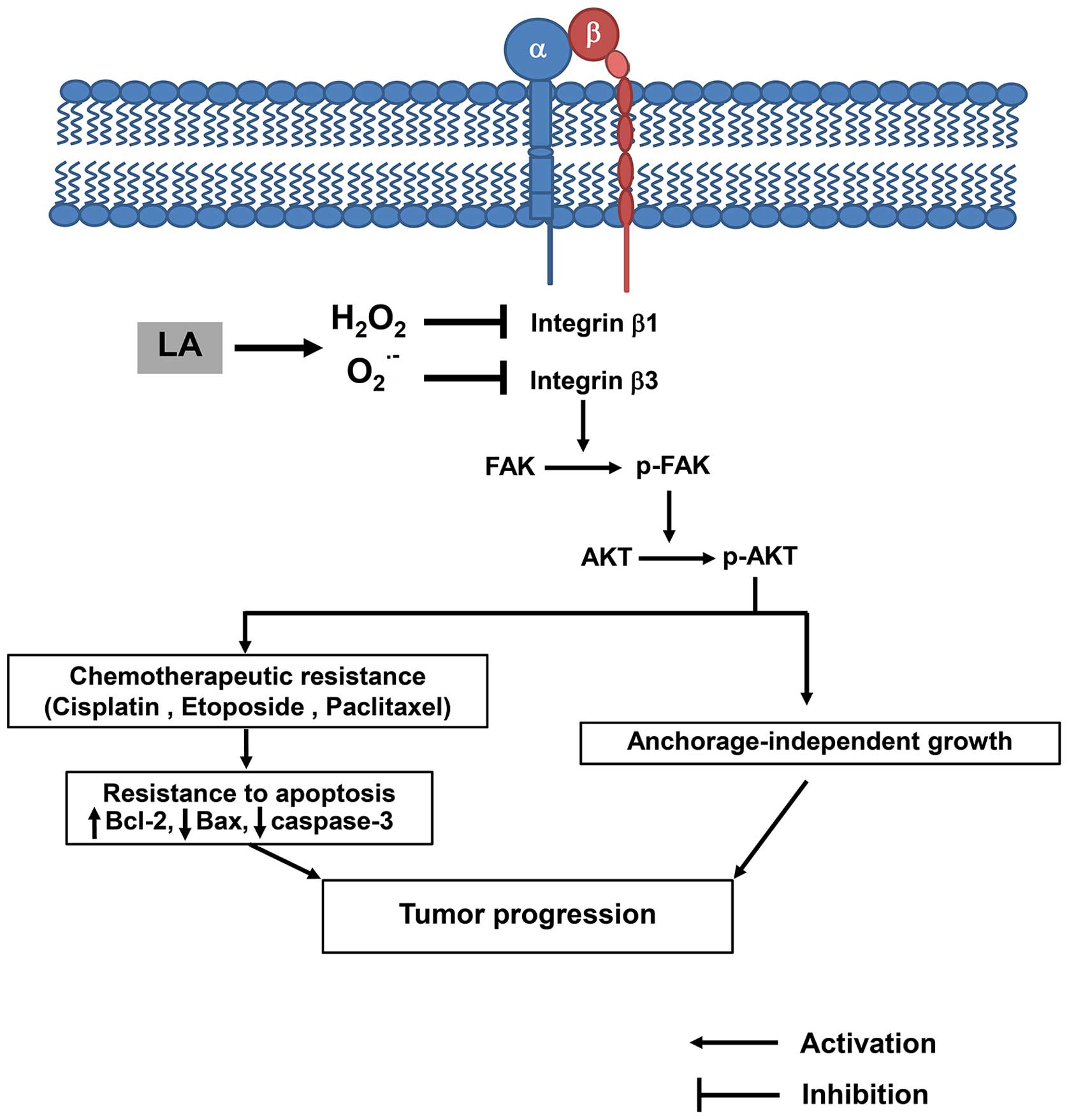α-Lipoic acid sensitizes lung cancer cells to chemotherapeutic agents and anoikis via integrin β1/β3 downregulation
- Authors:
- Published online on: July 18, 2016 https://doi.org/10.3892/ijo.2016.3624
- Pages: 1445-1456
Abstract
Introduction
Lung cancer is one of the most common malignancies responsible for the high mortality of patients worldwide (1). Due to aggressive behavior of lung cancer cells including high metastasis and chemotherapeutic resistance, lung cancer patients experience tumor recurrence after successful therapy (2,3). In terms of metastasis, anoikis, a cellular process of detachment-induced apoptosis, has been accepted as pivotal inhibitory mechanism (2). Metastatic cancer cells, therefore, acquire molecular mechanisms to overcome anoikis by upregulating their survival signals (4). Likewise, resistance to anticancer drugs has been shown to strongly associate with the augmentation of several survival pathways (5–8), and among them phosphatidylinositol 3′-kinase/protein kinase B (PI3K/AKT) is a central signal in mediating chemotherapeutic resistance in most cancers (9–12). Not only the active AKT (p-AKT) predominantly stimulates the survival of the cells, but it also acts through NF-κB to induce proliferation, invasion, and metastasis (13). In terms of survival, p-AKT stimulates the expression of anti-apoptotic B-cell lymphoma-2 (Bcl-2) family proteins, Bcl-2 and Mcl-1, while suppresses proapoptotic proteins such as Bad, Bax, Bid and Bim (14). Bcl-2 regulates the intrinsic apoptotic pathway by inhibiting with the release of cytochrome c from the mitochondria or binding to apoptotic protease activating factor 1 (Apaf-1) through the interaction with Bax (15). Bcl-2 is overexpressed in many cancers including small cell lung cancer (SCLC) and non-small cell lung cancer (NSCLC) and its upregulation was reported to associate with chemotherapeutic resistance (16,17).
Mounting evidence indicated that certain integrins such as integrin β1 and β3 are important in triggering AKT activation (18–21). Integrin β1 is a collagen receptor that induces specific cell signal distinct from those activated by other integrins. Adhesion of the cells by means of integrin β1 was shown to induce the phosphorylation of AKT through PI3K-dependent mechanism (18). Likewise, integrin β3 was shown in highly metastatic prostate cancer cells to induce migration through AKT (20). In addition to mentioned contexts, the interaction of integrin to extracellular matrix (ECM) provides cellular AKT survival signals through the activation of focal adhesion kinase (FAK) (4).
Considerable attention has been paid in searching of the safe natural compounds that can support chemotherapy as well as prevent metastasis. Among them, α-lipoic acid (LA) has been accepted as a promising natural compound to be used in cancer patients due to its direct anticancer activity against various cancers with sufficient safety information (22–26). Previously, we have shown that LA induces lung cancer cell apoptosis through ROS-dependent Bcl-2 downregulation (24). However, the effect of LA in regulation of integrins as well as anoikis and cancer response to chemotherapy are largely unknown. We hypothesize that LA may affect the pattern of cellular integrins due to its ability to modify ROS status of the cells. In detail, this compound may shift the redox status toward increased specific ROS, and such specific ROS regulate the integrin expression and signaling through AKT as well as susceptibility to anoikis and drug-induced cell death. Such knowledge might benefit further investigation and the development of this natural compound for anticancer approach.
Materials and methods
Cell culture and reagents
Human lung cancer epithelial H460 cells were obtained from the American Type Culture Collection (ATCC, Manassas, VA, USA). The cells were cultivated in Roswell Park Memorial Institute (RPMI)-1640 medium supplemented with 2 mM L-glutamine, 10% fetal bovine serum (FBS) and 100 U/ml of penicillin/streptomycin. Cell cultures were maintained in a 5% CO2 environment at 37°C. Cells were routinely passaged at preconfluent density using a 0.25% trypsin solution with 0.53 mM EDTA. RPMI-1640 medium, FBS, L-glutamine, penicillin/streptomycin, phosphate-buffered saline (PBS), trypsin, and EDTA were purchased from Gibco (Grand Island, NY, USA). LA, cisplatin, catalase, Hoechst33342, N-acetylcysteine (NAC), propidium iodide (PI), dimethylsulfoxide (DMSO), absolute ethanol, 3-(4,5-dimethylthiazol-2-yl)-2,5-diphenyl-tetrazolium bromide (MTT), 2,7-dichlorofluorescein diacetate (DCFH2-DA), dihydroethidium (DHE) and hydroxyphenyl fluorescein (HPF) were obtained from Sigma Chemical, Inc. (St. Louis, MO, USA). LA was prepared by dissolving in absolute ethanol, and stock sample was further diluted in culture medium. The final concentration of absolute ethanol used in all of the experiments was 0.1%. The results from the treated cells were compared with the non-treated cell exposed to the 0.1% final concentration of absolute ethanol. Paclitaxel, etoposide, Mn (III) tetrakis (4-benzoic acid) porphyrin chloride (MnTBAP) were obtained from Calbiochem (San Diego, CA, USA). Agarose was obtained from Bio-Rad (Hercules, CA, USA). Antibodies for Bcl-2, Mcl-1, Bax, caspase-3, FAK, phosphorylated FAK (Y397), AKT, phosphorylated AKT (S473), integrin α5, integrin αv, integrin β1, integrin β3, β-actin and peroxidase-labeled specific secondary antibodies were obtained from Cell Signaling Technology, Inc. (Denver, MA, USA).
Assessment of cell viability
Cell viability was determined by MTT colorimetric assay. Briefly, after specific treatments, cells in 96-well plates were incubated with 0.4 mg/ml of MTT for 4 h at 37°C in the dark. The supernatant was then removed and DMSO was added to dissolve the formazan product. The intensity was measured at 570 nm using a microplate reader (Anthros, Durham, NC, USA). The optical density ratio of treated to non-treated control cells was calculated and presented in terms of relative cell viability.
Nuclear staining assay
Apoptotic and necrotic cell death were detected by Hoechst33342 and PI co-staining. After specific treatments, cells were stained with 10 μM of the Hoechst33342 and 5 μM PI dyes for 30 min at 37°C. The apoptotic cells having condensed chromatin and/or fragmented nuclei are presented as bright blue fluorescence of Hoechst33342, while PI stained cells indicate necrosis. Mode of cell death was visualized and scored under a fluorescent microscope (Olympus IX51 with DP70).
Proliferation assay
Human lung cancer cells were seeded at a density of 2×103 cells/well in 96-well plates. Cell proliferation was determined by MTT assay at 0, 24, 48, and 72 h after exposure to LA at indicated concentrations (0–10 μM) for 48 h. The absorbance of formazan product which was dissolved by DMSO was measured by spectrophotometry at 570 nm using a microplate reader.
Anchorage-independent growth assay
Anchorage-independent growth was analyzed by the colony formation assay in soft agar. Briefly, 250 μl of the bottom layer which was a mixture of 1% agarose and completed RPMI-1640 media at a ratio 1:1 was prepared in 24-well plates. A single cell suspension of treated-H460 cells with non-toxic concentration (0–10 μM) of LA for 48 h was used to prepare the upper layer. The top layer composed with 0.335% agarose containing the cells at 1×103 in 250 μl. Then completed RPMI medium (250 μl/well) was added and refilled every 3 days. The colony formation was determined after 2 weeks using a phase-contrast microscope (Olympus IX51 with DP70).
Western blot analysis
After specific treatments, the cells were incubated in lysis buffer containing 20 mM Tris-HCl (pH 7.5), 1% Triton X-100, 150 mM sodium chloride, 10% glycerol, 1 mM sodium orthovanadate, 50 mM sodium fluoride, 100 mM phenylmethylsulfonyl fluoride, and a protease inhibitor cocktail (Roche Molecular Biochemicals, Indianapolis, IN, USA) for 1 h on ice. The cell lysate was collected, and the protein content was determined using the BCA protein assay kit (Thermo Scientific, Waltham, MA, USA). Equal amount of protein from each sample were denatured by heating at 95°C for 5 min and subsequently loaded onto 10% SDS-PAGE. After separation, proteins were transferred onto 0.45-μm nitrocellulose membranes (Bio-Rad). Transferred membranes were blocked for 1 h in 5% non-fat dry milk in TBST (25 mM Tris-HCl pH 7.5, 125 mM NaCl, and 0.05% Tween-20) and incubated overnight with specific primary antibodies at 4°C. Then, the membranes were washed three times with TBST and incubated with appropriate horseradish peroxidase-labeled secondary antibodies for 2 h at room temperature. The immune complexes were detected by SuperSignal West Pico chemiluminescent substrate (Pierce Biotechnology) and quantified using analyst/PC densitometry software (Bio-Rad).
ROS detection
Intracellular hydrogen peroxide (H2O2), superoxide anion (O2·−) and hydroxyl radical (OH·) were determined by flow cytometry using DCFH2-DA, DHE and HPF as fluorescent probes, respectively. Cells at 1.5×105 cells/well were seeded overnight into 6-well plates. Before LA treatment, the cells were incubated either with 10 μM DCFH2-DA, 10 μM DHE or 10 μM HPF for 30 min at 4°C, after which they were washed with PBS and treated with 10 μM of LA for 1–3 h. After the indicated time, cells were washed, resuspended in PBS, and immediately analyzed for fluorescence intensity using FACSCalibur (Beckton-Dickinson, Rutheford, NJ, USA) at the excitation and emission wavelengths of 488 and 538 nm, respectively, for detecting DCF fluorescence, at 488 and 610 nm for DHE and 490 and 515 nm for HPF. Mean fluorescence intensity was quantified by CellQuest software (Becton-Dickinson, Franklin Lakes, NJ, USA) analysis of the recorded histograms. Relative fluorescence was calculated as a ratio of the treated to the non-treated control fluorescence intensity.
Statistical analysis
All data were expressed as the means ± SD from three or more independent experiments. Multiple comparisons were examined for significant differences of multiple groups, using analysis of variance (ANOVA), followed by individual comparisons with the Scheffe’s post hoc test. Statistical significance was set at p<0.05.
Results
Effects of LA on viability of human lung cancer H460 cells
The non-toxic concentrations of LA were first determined. Human lung cancer H460 cells were cultured in RPMI medium in the absence or presence of LA (0–100 μM) for 48 h, and cell viability was determined by MTT viability assay. The results indicated that treatment with 0–10 μM of LA caused no significant difference of % cell viability in H460 lung cancer cells compared with non-treated control cells (Fig. 1A). The cytotoxicity effect of LA was early observed in the presence of 50 μM LA with ~85% viable cells. To confirm the effect of LA on cell toxicity, mode of cell death was evaluated by Hoechst33342 and PI co-staining assay. Fig. 1B and C demonstrate that apoptotic cells containing condensed and/or fragmented nuclei were not detectable in response to LA treatment at the concentrations of 0–10 μM. Treatment doses of 50 and 100 μM caused a significant increase in cell apoptosis over the control, while necrosis was barely detected in any of the concentrations.
LA sensitizes anoikis and inhibits anchorage-independent growth
The ability to grow independently of cell adhesion of tumor cells has been shown to be an important hallmark of aggressive metastatic cells (4,14). Next, the effect of LA on anchorage-independent survival and growth was investigated by soft agar colony formation assay. The cells were pretreated with LA at non-toxic concentrations for 48 h prior to subject in the layer of agarose containing RPMI medium as described in Materials and methods. Fig. 2A, C and D show that LA treatment significantly inhibited survival and growth of the lung cancer cells in a dose-dependent manner. Both the number and size of colonies were significantly suppressed in LA-treated cells in comparison to those of non-treated control. Our results revealed that LA treatment sensitizes anoikis and inhibits growth of these cells in detached condition as indicated by the significant decrease in the number and size of colonies, respectively.
Additionally, anti-proliferative effect of LA at non-toxic concentrations (0–10 μM) was further evaluated in normal cell adherent condition. Fig. 2B indicates that 10 μM of LA obviously suppressed proliferation of human lung cancer cells. Taken together, our results have demonstrated the effects of LA in sensitization of anoikis, inhibition of tumor growth in both anchorage-dependent and -independence conditions.
LA depletes integrin β1, and β3
As recent evidence has reported the role of certain integrins such as integrin α5, αv, β1 and β3 in potentiating lung cancer anoikis resistance, migration, and metastasis (4,27,28), the expression of integrins in response to LA treatment was analyzed. The lung cancer cells were exposure to non-toxic concentrations of LA as previously described and the levels of integrin α5, αv, β1 and β3 were examined by western blotting. Fig. 3A and B illustrate the dramatic reduction of integrin β1 and β3 in response to LA treatment. In terms of integrin α5 and αv, we found no alteration.
Integrins were shown to mediate anoikis resistance in various cancer cells by increasing cellular survival signals such as FAK and PI3K/AKT pathways (4,29). We further tested such downstream molecular targets of integrins and found that in correlation to integrin β1 and β3 depletion, p-FAK and p-AKT were strongly downregulated in the presence of LA at the concentrations of 0–10 μM, whereas, there was no difference in the level of total FAK and AKT (Fig. 3C and D). These data suggested the possible mechanism of LA in attenuation of anoikis resistance and growth via the suppression of integrins and their related downstream pro-survival pathway.
LA sensitizes chemotherapy-induced apoptosis in human lung cancer cells
Substantial evidence has indicated the role of integrins in regulation of chemotherapy resistance (27,30–32). Therefore, we evaluated the effect of LA treatment on the susceptibility to current chemotherapeutic drugs used for lung cancer treatment. H460 lung cancer cells were cultured in completed RPMI medium with or without non-toxic concentrations (0–10 μM) of LA for 48 h. Cisplatin, etoposide or paclitaxel was then added into pretreated cells for 24 h, before viable cells were detected by MTT assay. As presented in Fig. 4A–C, the incubation of H460 cells with either 25 μM cisplatin, 25 μM etoposide, or 0.1 μM paclitaxel for 24 h significantly reduced cell viability to 88.89, 81.62 and 77.17%, respectively. Importantly, pretreatment of the cells with non-toxic concentration of LA (10 μM) for 48 h prior to drug treatment remarkably sensitized the lung cancer cells to drug-induced apoptosis (Fig. 4D–F). It is worth noting herein that the sensitization to cisplatin- and etoposide-induced apoptosis was also found in lung cancer cell pretreated with of LA at low dose (5 μM) (Fig. 4D and E). These findings add the information that the observed depletion of integrin β1 and β3 and their survival counterparts mediated by LA influence drug susceptibility in these lung cancer cells.
Furthermore, we evaluated the effect of LA on survival and apoptosis regulatory proteins namely p-FAK, FAK, p-AKT, AKT, Mcl-1, Bcl-2, Bax, and caspase-3. The cells were pretreated with 10 μM of LA for 48 h, treated with cisplatin, etoposide, or paclitaxel for 24 h, and the proteins were determined by western blotting. As expected treatment of the cells with either LA or drug alone significantly reduced p-FAK and p-AKT (Fig. 5). The combination of LA and drug caused further reduction of such survival proteins. Also, the downstream anti- and proapoptotic members of Bcl-2 family protein were evaluated. We found the key anti-apoptotic proteins Bcl-2 and Mcl-1 significantly depleted in response to LA and drug treatment, while the proapoptotic Bax significantly increased (Fig. 6). Also, the cleavage form of caspase-3 significantly increased in response to the combination treatment. Taken together, we provide supportive information that LA sensitizes the cell response to chemotherapeutic drugs via FAK and AKT-dependent mechanism.
O2·− and H2O2 regulate integrin expression in LA treated-lung cancer cells
Reactive oxygen species (ROS) are crucial signaling molecules in cell biology. They have been shown to regulate protein expression in many steps of protein processing including transcription, translation, and degradation (24,33–37). In order to clarify the underlying mechanism of LA in downregulation of integrins, we determined the change in cellular ROS in response to LA treatment. Flow cytometry was used to evaluate cellular ROS level with the specific ROS fluorescence dyes. Fluorescent intensity of DCFH2-DA, DHE and HPF reflects the amounts of H2O2, O2·− and OH·, respectively. Fig. 7B indicates that treatment of the cells with 10 μM LA significantly increased intracellular O2·− and H2O2. However, there was no alteration of OH· level in the cell treated with LA (Fig. 7).
In order to link that such ROS-induced by LA regulate integrin alteration, broad and specific ROS scavengers were added prior to LA treatment, and the level of integrin β1 and β3 was determined by western blot analysis. Fig. 8A and B show that treatment of the cells with NAC, a broad ROS scavenger successfully restored the expression of integrin β1 and β3. Attractively, H2O2 scavenger, catalase specifically prevented the reduction of integrin β1 but not β3 in LA-treated H460 cells (Fig. 8C and D). Integrin β3 was preserved by the pretreatment with O2·− scavenger (MnTBAP), but such scavenger has no effect on integrin β1 (Fig. 8E and F). Thus, our results suggested that LA decreases integrin β1 via H2O2 induction, while reduces integrin β3 via O2·−.
To provide supportive information regarding the role of specific ROS-mediating effect of LA on integrin alteration, anoikis, and drug responses, the cells were pretreated with specific ROS scavengers, treated with LA, and subjected to anchorage-independent growth or drug sensitization assays as previously described. Results indicated that the pan ROS scavenger NAC and H2O2 scavenger, catalase abolished effects of LA on anoikis as well as drug-mediated apoptosis (Fig. 8G and H). Moreover, MnTBAP, O2·− scavenger, inhibited anoikis induction effect but had only slightly effect on chemosensitization (Fig. 8G and H). These results confirmed the mechanistic roles of specific ROS on LA sensitization of lung cancer cells to anoikis and chemotherapeutic agents.
Discussion
Due to its safety profile and anticancer activity, LA has garnered interests as a potential compound for cancer therapy. LA was shown to sensitize cancer cells to apoptosis by modulating cellular redox status resulting in the downregulation of anti-apoptotic and pro-survival proteins (24,26,38). Herein we provide novel information regarding regulatory effect of LA on intergrin pattern through specific ROS induction. The H2O2 and O2·− induced by LA treatment caused the decrease of integrin β1 and β3, respectively. As integrins are the key initiators for AKT through the interaction with ECM proteins (39), and AKT provides major cell survival signals (40), the decline of such integrins are likely to weakening the cancer cells.
Substantial evidence indicates that the abilities of cells to resist anoikis as well as chemotherapeutic drug-induced apoptosis are major obstacles for the positive clinical outcome in lung cancer patients (2,3). In general, resistance to chemotherapeutic agents in cancers is caused by many possible ways including active drug efflux, high level of survival proteins, modification of drug targets, and mutation in cellular checkpoint signals (41). In lung cancer, the role of AKT on drug resistance has been highlighted as it was shown to be constitutively active in NSCLC cells and such an activation status of the protein strongly promotes cellular survival and resistance to chemotherapy and radiation (9). As generators of cellular AKT signal, integrins, transmembrane receptors, have garnered increasing attention in the cancer research field. In particular, the increase of certain integrins in the cancer cells was shown to be tightly associated with the augmented metastasis and drug resistance. Integrin β1 causes chemotherapy resistance through the activation of PI3K/AKT pathway, and the depletion of such an integrin regained apoptosis response to cisplatin and gefitinib in lung cancer cells (27,31,42,43). Besides, overexpression of integrin β1 is required for anoikis resistance and anchorage-independent growth (44), suggesting a positive role of this integrin on cancer metastasis. Likewise, previous study demonstrated that integrin β3 positively affects anchorage-independent growth of lung cancer cells (45). Consistent with these findings, we found that downregulation of integrins β1 and β3 mediated by LA reversed drug and anoikis resistance (Figs. 2Figure 3–4).
Roles of ROS in cancer pathology are well established especially in terms of survival and death (46–48), and aggressive behavior such as chemotherapeutic resistance, survival in detachment condition, migration and invasion (33,35,49). LA has been shown to act as a prooxidant (50,51) as well as an anti-oxidant (52,53) depending on cell type and cellular redox status. Various studies have reported on ROS induction activity of LA in cancer cells (24,25). Our results showed that treatment of the lung cancer cells with LA resulted in the significant increase of intracellular O2·− and H2O2 (Fig. 7). Using specific anti-oxidants, broad ROS scavenger NAC, O2·− scavenger MnTBAP, and H2O2 scavenger catalase, successfully reversed the effects of LA on integrin β1 and β3 expression (Fig. 8A–F), drug sensitization (Fig. 8G), anchorage-independent colony formation (Fig. 8H). Nevertheless, O2·− and H2O2 are reactive molecules produced in the stressed cells and/or in crosstalk between cells and inflammation within the tumor microenvironment (54). The knowledge gained from this study may improve the understanding of the molecular basis of ROS on integrins in lung cancer.
In conclusion, our data provide evidence that LA regulates integrin expression pattern and sensitizes human lung cancer cells to anoikis and chemotherapy. LA decreases integrin β1 and β3 via specific ROS induction (Fig. 9). These data provide novel anticancer approaches that may support the development of LA to benefit anticancer therapy.
Acknowledgements
This study was supported by Grant for International Research Integration: Chula Research Scholar, Ratchadaphiseksomphot Endowment Fund.
References
|
Molina JR, Yang P, Cassivi SD, Schild SE and Adjei AA: Non-small cell lung cancer: Epidemiology, risk factors, treatment, and survivorship. Mayo Clin Proc. 83:584–594. 2008. View Article : Google Scholar : PubMed/NCBI | |
|
Hunter KW, Crawford NPS and Alsarraj J: Mechanisms of metastasis. Breast Cancer Res. 10(Suppl 1): S2. 2008. View Article : Google Scholar : | |
|
Merk J, Rolff J, Dorn C, Leschber G and Fichtner I: Chemoresistance in non-small-cell lung cancer: Can multidrug resistance markers predict the response of xenograft lung cancer models to chemotherapy? Eur J Cardiothorac Surg. 40:e29–e33. 2011. View Article : Google Scholar : PubMed/NCBI | |
|
Paoli P, Giannoni E and Chiarugi P: Anoikis molecular pathways and its role in cancer progression. Biochim Biophys Acta. 1833:3481–3498. 2013. View Article : Google Scholar : PubMed/NCBI | |
|
Igney FH and Krammer PH: Death and anti-death: Tumour resistance to apoptosis. Nat Rev Cancer. 2:277–288. 2002. View Article : Google Scholar : PubMed/NCBI | |
|
Liu Q-H, Shi M-L, Sun C, Bai J and Zheng J-N: Role of the ERK1/2 pathway in tumor chemoresistance and tumor therapy. Bioorg Med Chem Lett. 25:192–197. 2015. View Article : Google Scholar | |
|
McCubrey JA, Steelman LS, Chappell WH, Abrams SL, Wong EW, Chang F, Lehmann B, Terrian DM, Milella M, Tafuri A, et al: Roles of the Raf/MEK/ERK pathway in cell growth, malignant transformation and drug resistance. Biochim Biophys Acta. 1773:1263–1284. 2007. View Article : Google Scholar | |
|
Wilson TR, Longley DB and Johnston PG: Chemoresistance in solid tumours. Ann Oncol. 17(Suppl 10): x315–x324. 2006. View Article : Google Scholar : PubMed/NCBI | |
|
Brognard J, Clark AS, Ni Y and Dennis PA: Akt/protein kinase B is constitutively active in non-small cell lung cancer cells and promotes cellular survival and resistance to chemotherapy and radiation. Cancer Res. 61:3986–3997. 2001.PubMed/NCBI | |
|
Pommier Y, Sordet O, Antony S, Hayward RL and Kohn KW: Apoptosis defects and chemotherapy resistance: Molecular interaction maps and networks. Oncogene. 23:2934–2949. 2004. View Article : Google Scholar : PubMed/NCBI | |
|
West KA, Castillo SS and Dennis PA: Activation of the PI3K/Akt pathway and chemotherapeutic resistance. Drug Resist Updat. 5:234–248. 2002. View Article : Google Scholar | |
|
Wongvaranon P, Pongrakhananon V, Chunhacha P and Chanvorachote P: Acquired resistance to chemotherapy in lung cancer cells mediated by prolonged nitric oxide exposure. Anticancer Res. 33:5433–5444. 2013.PubMed/NCBI | |
|
Dolcet X, Llobet D, Pallares J and Matias-Guiu X: NF-κB in development and progression of human cancer. Virchows Arch. 446:475–482. 2005. View Article : Google Scholar : PubMed/NCBI | |
|
Chiarugi P and Giannoni E: Anoikis: A necessary death program for anchorage-dependent cells. Biochem Pharmacol. 76:1352–1364. 2008. View Article : Google Scholar : PubMed/NCBI | |
|
Adams JM and Cory S: Bcl-2-regulated apoptosis: Mechanism and therapeutic potential. Curr Opin Immunol. 19:488–496. 2007. View Article : Google Scholar : PubMed/NCBI | |
|
Sartorius UA and Krammer PH: Upregulation of Bcl-2 is involved in the mediation of chemotherapy resistance in human small cell lung cancer cell lines. Int J Cancer. 97:584–592. 2002. View Article : Google Scholar : PubMed/NCBI | |
|
Harada T, Ogura S, Yamazaki K, Kinoshita I, Itoh T, Isobe H, Yamashiro K, Dosaka-Akita H and Nishimura M: Predictive value of expression of P53, Bcl-2 and lung resistance-related protein for response to chemotherapy in non-small cell lung cancers. Cancer Sci. 94:394–399. 2003. View Article : Google Scholar : PubMed/NCBI | |
|
Velling T, Nilsson S, Stefansson A and Johansson S: beta1-Integ-rins induce phosphorylation of Akt on serine 473 independently of focal adhesion kinase and Src family kinases. EMBO Rep. 5:901–905. 2004. View Article : Google Scholar : PubMed/NCBI | |
|
Bhattacharya S, Ray RM and Johnson LR: Integrin beta3-mediated Src activation regulates apoptosis in IEC-6 cells via Akt and STAT3. Biochem J. 397:437–447. 2006. View Article : Google Scholar : PubMed/NCBI | |
|
Zheng DQ, Woodard AS, Tallini G and Languino LR: Substrate specificity of alpha(v)beta(3) integrin-mediated cell migration and phosphatidylinositol 3-kinase/AKT pathway activation. J Biol Chem. 275:24565–24574. 2000. View Article : Google Scholar : PubMed/NCBI | |
|
Ivaska J, Nissinen L, Immonen N, Eriksson JE, Kähäri VM and Heino J: Integrin alpha 2 beta 1 promotes activation of protein phosphatase 2A and dephosphorylation of Akt and glycogen synthase kinase 3 beta. Mol Cell Biol. 22:1352–1359. 2002. View Article : Google Scholar : PubMed/NCBI | |
|
Dozio E, Ruscica M, Passafaro L, Dogliotti G, Steffani L, Marthyn P, Pagani A, Demartini G, Esposti D, Fraschini F, et al: The natural antioxidant alpha-lipoic acid induces p27(Kip1)-dependent cell cycle arrest and apoptosis in MCF-7 human breast cancer cells. Eur J Pharmacol. 641:29–34. 2010. View Article : Google Scholar : PubMed/NCBI | |
|
Feuerecker B, Pirsig S, Seidl C, Aichler M, Feuchtinger A, Bruchelt G and Senekowitsch-Schmidtke R: Lipoic acid inhibits cell proliferation of tumor cells in vitro and in vivo. Cancer Biol Ther. 13:1425–1435. 2012. View Article : Google Scholar : PubMed/NCBI | |
|
Moungjaroen J, Nimmannit U, Callery PS, Wang L, Azad N, Lipipun V, Chanvorachote P and Rojanasakul Y: Reactive oxygen species mediate caspase activation and apoptosis induced by lipoic acid in human lung epithelial cancer cells through Bcl-2 down-regulation. J Pharmacol Exp Ther. 319:1062–1069. 2006. View Article : Google Scholar : PubMed/NCBI | |
|
Simbula G, Columbano A, Ledda-Columbano GM, Sanna L, Deidda M, Diana A and Pibiri M: Increased ROS generation and p53 activation in α-lipoic acid-induced apoptosis of hepatoma cells. Apoptosis. 12:113–123. 2007. View Article : Google Scholar | |
|
Wenzel U, Nickel A and Daniel H: α-Lipoic acid induces apoptosis in human colon cancer cells by increasing mitochondrial respiration with a concomitant O2−·-generation. Apoptosis. 10:359–368. 2005. View Article : Google Scholar : PubMed/NCBI | |
|
Maiuthed A and Chanvorachote P: Cisplatin at sub-toxic levels mediates integrin switch in lung cancer cells. Anticancer Res. 34:7111–7117. 2014.PubMed/NCBI | |
|
Caccavari F, Valdembri D, Sandri C, Bussolino F and Serini G: Integrin signaling and lung cancer. Cell Adhes Migr. 4:124–129. 2010. View Article : Google Scholar | |
|
Guadamillas MC, Cerezo A and Del Pozo MA: Overcoming anoikis - pathways to anchorage-independent growth in cancer. J Cell Sci. 124:3189–3197. 2011. View Article : Google Scholar : PubMed/NCBI | |
|
Aoudjit F and Vuori K: Integrin signaling inhibits paclitaxel-induced apoptosis in breast cancer cells. Oncogene. 20:4995–5004. 2001. View Article : Google Scholar : PubMed/NCBI | |
|
Hodkinson PS, Mackinnon AC and Sethi T: Extracellular matrix regulation of drug resistance in small-cell lung cancer. Int J Radiat Biol. 83:733–741. 2007. View Article : Google Scholar : PubMed/NCBI | |
|
Meadows GG: Integration/Interaction of Oncologic Growth. Springer Science & Business Media; 2005, View Article : Google Scholar | |
|
Luanpitpong S, Talbott SJ, Rojanasakul Y, Nimmannit U, Pongrakhananon V, Wang L and Chanvorachote P: Regulation of lung cancer cell migration and invasion by reactive oxygen species and caveolin-1. J Biol Chem. 285:38832–38840. 2010. View Article : Google Scholar : PubMed/NCBI | |
|
Pongrakhananon V, Nimmannit U, Luanpitpong S, Rojanasakul Y and Chanvorachote P: Curcumin sensitizes non-small cell lung cancer cell anoikis through reactive oxygen species-mediated Bcl-2 downregulation. Apoptosis. 15:574–585. 2010. View Article : Google Scholar : PubMed/NCBI | |
|
Wang L, Chanvorachote P, Toledo D, Stehlik C, Mercer RR, Castranova V and Rojanasakul Y: Peroxide is a key mediator of Bcl-2 down-regulation and apoptosis induction by cisplatin in human lung cancer cells. Mol Pharmacol. 73:119–127. 2008. View Article : Google Scholar | |
|
Rungtabnapa P, Nimmannit U, Halim H, Rojanasakul Y and Chanvorachote P: Hydrogen peroxide inhibits non-small cell lung cancer cell anoikis through the inhibition of caveolin-1 degradation. Am J Physiol Cell Physiol. 300:C235–C245. 2011. View Article : Google Scholar : | |
|
Chanvorachote P, Pongrakhananon V, Wannachaiyasit S, Luanpitpong S, Rojanasakul Y and Nimmannit U: Curcumin sensitizes lung cancer cells to cisplatin-induced apoptosis through superoxide anion-mediated Bcl-2 degradation. Cancer Invest. 27:624–635. 2009. View Article : Google Scholar : PubMed/NCBI | |
|
Shi DY, Liu HL, Stern JS, Yu PZ and Liu SL: Alpha-lipoic acid induces apoptosis in hepatoma cells via the PTEN/Akt pathway. FEBS Lett. 582:1667–1671. 2008. View Article : Google Scholar : PubMed/NCBI | |
|
Giancotti FG and Ruoslahti E: Integrin signaling. Science. 285:1028–1032. 1999. View Article : Google Scholar : PubMed/NCBI | |
|
Vivanco I and Sawyers CL: The phosphatidylinositol 3-Kinase AKT pathway in human cancer. Nat Rev Cancer. 2:489–501. 2002. View Article : Google Scholar : PubMed/NCBI | |
|
Zahreddine H and Borden KL: Mechanisms and insights into drug resistance in cancer. Front Pharmacol. 4:282013. View Article : Google Scholar : PubMed/NCBI | |
|
Sethi T, Rintoul RC, Moore SM, MacKinnon AC, Salter D, Choo C, Chilvers ER, Dransfield I, Donnelly SC, Strieter R, et al: Extracellular matrix proteins protect small cell lung cancer cells against apoptosis: A mechanism for small cell lung cancer growth and drug resistance in vivo. Nat Med. 5:662–668. 1999. View Article : Google Scholar : PubMed/NCBI | |
|
Morello V, Cabodi S, Sigismund S, Camacho-Leal MP, Repetto D, Volante M, Papotti M, Turco E and Defilippi P: β1 integrin controls EGFR signaling and tumorigenic properties of lung cancer cells. Oncogene. 30:4087–4096. 2011. View Article : Google Scholar : PubMed/NCBI | |
|
Schooley AM, Andrews NM, Zhao H and Addison CL: β1 integrin is required for anchorage-independent growth and invasion of tumor cells in a context dependent manner. Cancer Lett. 316:157–167. 2012. View Article : Google Scholar | |
|
Ninsontia C and Chanvorachote P: Ouabain mediates integrin switch in human lung cancer cells. Anticancer Res. 34:5495–5502. 2014.PubMed/NCBI | |
|
Clerkin JS, Naughton R, Quiney C and Cotter TG: Mechanisms of ROS modulated cell survival during carcinogenesis. Cancer Lett. 266:30–36. 2008. View Article : Google Scholar : PubMed/NCBI | |
|
Luanpitpong S, Chanvorachote P, Nimmannit U, Leonard SS, Stehlik C, Wang L and Rojanasakul Y: Mitochondrial super-oxide mediates doxorubicin-induced keratinocyte apoptosis through oxidative modification of ERK and Bcl-2 ubiquitination. Biochem Pharmacol. 83:1643–1654. 2012. View Article : Google Scholar : PubMed/NCBI | |
|
Luanpitpong S, Nimmannit U, Chanvorachote P, Leonard SS, Pongrakhananon V, Wang L and Rojanasakul Y: Hydroxyl radical mediates cisplatin-induced apoptosis in human hair follicle dermal papilla cells and keratinocytes through Bcl-2-dependent mechanism. Apoptosis. 16:769–782. 2011. View Article : Google Scholar : PubMed/NCBI | |
|
Songserm T, Pongrakhananon V and Chanvorachote P: Sub-toxic cisplatin mediates anoikis resistance through hydrogen peroxide-induced caveolin-1 up-regulation in non-small cell lung cancer cells. Anticancer Res. 32:1659–1669. 2012.PubMed/NCBI | |
|
Dicter N, Madar Z and Tirosh O: α-lipoic acid inhibits glycogen synthesis in rat soleus muscle via its oxidative activity and the uncoupling of mitochondria. J Nutr. 132:3001–3006. 2002.PubMed/NCBI | |
|
Çakatay U, Kayali R, Sivas A and Tekeli F: Prooxidant activities of alpha-lipoic acid on oxidative protein damage in the aging rat heart muscle. Arch Gerontol Geriatr. 40:231–240. 2005. View Article : Google Scholar : PubMed/NCBI | |
|
Biewenga GP, Haenen GR and Bast A: The pharmacology of the antioxidant lipoic acid. Gen Pharmacol. 29:315–331. 1997. View Article : Google Scholar : PubMed/NCBI | |
|
Packer L, Witt EH and Tritschler HJ: alpha-Lipoic acid as a biological antioxidant. Free Radic Biol Med. 19:227–250. 1995. View Article : Google Scholar : PubMed/NCBI | |
|
Ziech D, Franco R, Georgakilas AG, Georgakila S, Malamou-Mitsi V, Schoneveld O, Pappa A and Panayiotidis MI: The role of reactive oxygen species and oxidative stress in environmental carcinogenesis and biomarker development. Chem Biol Interact. 188:334–339. 2010. View Article : Google Scholar : PubMed/NCBI |



